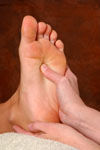This article is adapted from one published by Becky Cobb, of Balance and Harmony, in the July 2015 issues of Woman’s View.
A common question I hear is, “I am not sure how to pronounce it, but I have plantar fasciitis. Can reflexology help?”
The answer, according to many of my reflexology clients with plantar fasciitis, is YES. They often say:
- “I can’t believe the pain is gone.”

- “I had no pain for a week after the first session.”
- “I had no idea reflexology would help relieve the pain.”
- “This is amazing.”
What is Plantar Fasciitis?
Plantar fasciitis (PLAN-ter fash-ee-EYE-tus) strikes 2 million people a year and is most common in 40-60 year old women. The plantar fascia is a ligament that connects the toes to the heel bone and supports the arch of the foot. The main cause is over pronation of the foot, or rolling the foot inward while walking. This causes over stretching of the plantar fascia with every step. While it may seem the pain comes on suddenly, small tears in the fascia occur as it is strained over a long period of time. The most common symptom is pain in the heel, especially in the morning.
Other causes include:
- High arches or flat feet
- Walking, standing, or running for long periods of time, especially on hard surfaces
- Being overweight
- Wearing shoes that don’t fit well or are worn out
- Having tight Achilles tendons or calf muscles
What is Reflexology?
Reflexology is the application of pressure to areas on the feet, hands and ears. Reflexology is relaxing and is an effective way to alleviate stress. The theory behind reflexology is that these pressure points correspond to organs and systems of the body. Several studies funded by the National Cancer Institute and the National Institutes of Health indicate that reflexology may reduce pain and psychological symptoms, such as anxiety and depression, and enhance relaxation and sleep. Studies also show that reflexology may have benefits in palliative care of people with cancer. Click here to earn more about reflexology.
How Does Reflexology Help Plantar Fasciitis?
 Reflexology helps treat plantar fasciitis by loosening the ligaments and muscles in the foot and lower leg, by increasing circulation, and improving flexibility. Clients who routinely receive reflexology sessions experience less pain in the foot, heel and lower leg and are able to maintain full flexibility during routine activities.
Reflexology helps treat plantar fasciitis by loosening the ligaments and muscles in the foot and lower leg, by increasing circulation, and improving flexibility. Clients who routinely receive reflexology sessions experience less pain in the foot, heel and lower leg and are able to maintain full flexibility during routine activities.
Other Treatment Options Plantar Fasciitis
There is no one treatment that works for everyone. In addition to reflexology, other components of a treatment plan include:
- Resting the feet
- Stretching the toes and foot
- Orthotics or inserts for the shoes
- New shoes with good arch support and there is not one particular brand—it seems everyone has to find the brand that works best for his or her feet
- Ice for inflammation
- In extreme cases where the pain lasts for months or even years, an orthopedist will order shots or have the patient wear splints or a boot
Not everyone is a believer. As one clients says, she is not sure if it is the reflexology, but her foot is getting better so she keeps coming back. Some clients see results quickly and for others it may take a number of sessions.
Just as there is not one specific cause that can be pin pointed, the treatment varies for each person as well. But instead of being in pain for months, try reflexology sooner than later.
DISCLAIMER: Please read the disclaimer in the footer. Also note that the length of treatment and overall results vary from person to person. Most people notice some difference after one session but the best results are obtained with series of sessions and as part of an overall treatment plan.
How Do I Schedule a Reflexology Session?
Call (309) 692-7834 or check out the Balance and Harmony services page for pricing and details on scheduling your appointment.